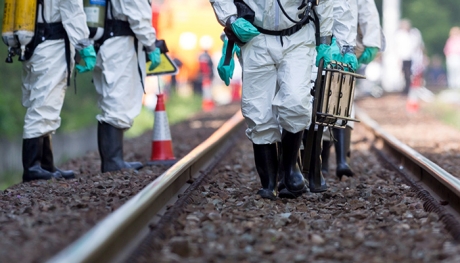Novel Exposure Assessment

Through air, water, consumer products, and food, we are exposed to a wide range of chemicals every day, which may impact our health. The EXPOSOME encompasses the totality of human environmental (i.e. non-genetic) exposures from conception onwards, complementing the genome. Through our faculty research and the Exposome Collaborative @ Johns Hopkins University, we are developing tools and technologies to conduct exposure assessment outdoors, indoors, and as wearable sensors.
Research Highlights
Determining potential chemical exposures from electronic cigarettes
Electronic cigarette (e-cig) use is increasing at an alarming rate, despite critical knowledge gaps on their toxicity and potential health effects. E-cig devices work by heating a mixture of chemicals (e-liquid) with a metallic coil to generate a fine aerosol that is inhaled by the user. Information on these chemicals is not typically disclosed by manufacturers. E-liquids comprise different proportions of propylene glycol, vegetable glycerin, nicotine, flavorings, and other chemicals (e.g. metals, phthalates, flame retardants), which, along with the chemicals that may be formed during the aerosol generation. We have found toxic metals in every sample analyzed, regardless of flavor or nicotine content. One concerning finding was that 50% of our samples had detectable levels of chromium (Cr), manganese (Mn), nickel (Ni), lead (Pb), and zinc (Zn) in e-liquid that had not been in contact with the heating coil. In addition to metals, our preliminary analyses showed over 500 compounds were detected in JUUL tobacco, mint and menthol-flavored e-cig aerosols, and only 53 were tentatively identified using online databases. This means that over 90% of the chemicals were not identified through online databases.
Evaluating low-cost sensor technology
We are evaluating how low-cost sensor technology can be used to evaluate neighborhood level variability in pollutant and greenhouse gas concentrations. To understand these processes at high spatiotemporal resolution and their implications for air quality and personal exposure, we built custom, low-cost air quality monitors that measure concentrations of contaminants relevant to human health and climate, including gases (O3, NO, NO2, CO, CO2, and CH4) and size-resolved (0.3-10 µm) particulate matter with ~45 units around the city of Baltimore. We will use this network data to evaluate spatial and temporal patterns in air pollution exposures and
Associated Faculty
Jacqueline Agnew, PhD
The goal of Dr. Agnew's research is to better understand the relationship between workplace exposures, worker characteristics, and musculoskeletal disorders so that these debilitating and expensive conditions can be prevented.
Daniel Barnett, MD
Dr. Barnett's work focuses on leveraging applied research to examining and enhancing public health preparedness systems’ readiness for disasters across the all-hazards continuum and across the disaster lifecycle.
Joseph Bressler, PhD*
Joe's laboratory has been studying transporters and their interaction with environmental toxins.
Jessie Buckley, PhD*
As an environmental and pediatric/perinatal epidemiologist, Jessie's goal is to conduct innovative and high impact research to inform environmental policies targeted at improving children’s health.
Peter DeCarlo, PhD*
Peter's research focuses on atmospheric air pollution with applications to ambient air quality, including atmospheric aerosols and emissions from anthropogenic activities including natural gas development.
Natalie Exum, PhD
Natalie is the Senior Technical Advisor for Water, Sanitation and Hygiene (WASH) for PMA2020's mobile health data collection platform. She oversees PMA2020 WASH surveys and data analysis in all program countries.
Chris Heaney, PhD*
Chris' research focuses on environmentally-mediated impacts on health and well-being, specifically community land use, waste disposal, and food production practices, and integrates the academic disciplines of environmental microbiology, molecular biology, immunology, epidemiology, and community-based participatory research (CBPR).
Kirsten Koehler, PhD*
Kirsten's goals are to improve exposure assessment methods to inform occupational and public health policy. Her research goals involve the use of direct-reading instrumentation to improve spatiotemporal exposure assessment. Direct-reading (i.e. “real-time”) monitors can rapidly assess exposures to various hazards.
Jordan Kuiper, PhD
Jordan is an environmental epidemiologist working on several projects related to early life chemical exposures and childhood health and developmental outcomes.
Scot Miller, PhD
Scot studies the emissions of greenhouse gases and air pollutants. His lab, the Greenhouse Gas Research Group, uses observations of greenhouse gases collected from airplanes, towers and satellites to estimate emissions across individual states to continents.
Keeve Nachman, PhD*
Keeve's research aims to generate the scientific evidence needed to support decisions that mitigate human exposures to chemical and microbial hazards associated with food production.
Nora Pisanic, PhD
Carsten Prasse, PhD*
Carsten's research focuses on the occurrence and fate of organic contaminants in the urban water cycle and their impact on environmental and human health. His recent research efforts have focused on the development of new screening methods to assess exposure to drinking water contaminants.
Gurumurthy "Ram" Ramachandran, PhD, CIH*
Ram has conducted research in various areas relating to human exposure assessment in occupational, residential, and outdoor settings. His research has included the development of occupational exposure assessment strategies for airborne contaminants.
Ana Rule, PhD*
Ana's main research goal is the development and evaluation of novel sampling and analysis strategies for the assessment of exposure to biological aerosols, e-cigarette aerosols, and particulate matter.
Kellogg Schwab, PhD*
Schwab's research laboratory focuses on environmental microbiology and engineering with an emphasis on the fate and transport of chemicals, emerging contaminants and pathogenic microorganisms in water, food, and the environment.
Fenna Sillé, PhD
The focus of Fenna's research is to understand the effects of environmental exposures on the development and function of our immune system.
Genee Smith, PhD*
Genee's research focuses on understanding the disproportionate burden of a changing climate on vulnerable populations and the impacts of neighborhood-level environmental exposures, including degraded infrastructure, unfair development, and chemical pollutants, on health disparities.
*Denotes faculty who are accepting PhD students.
